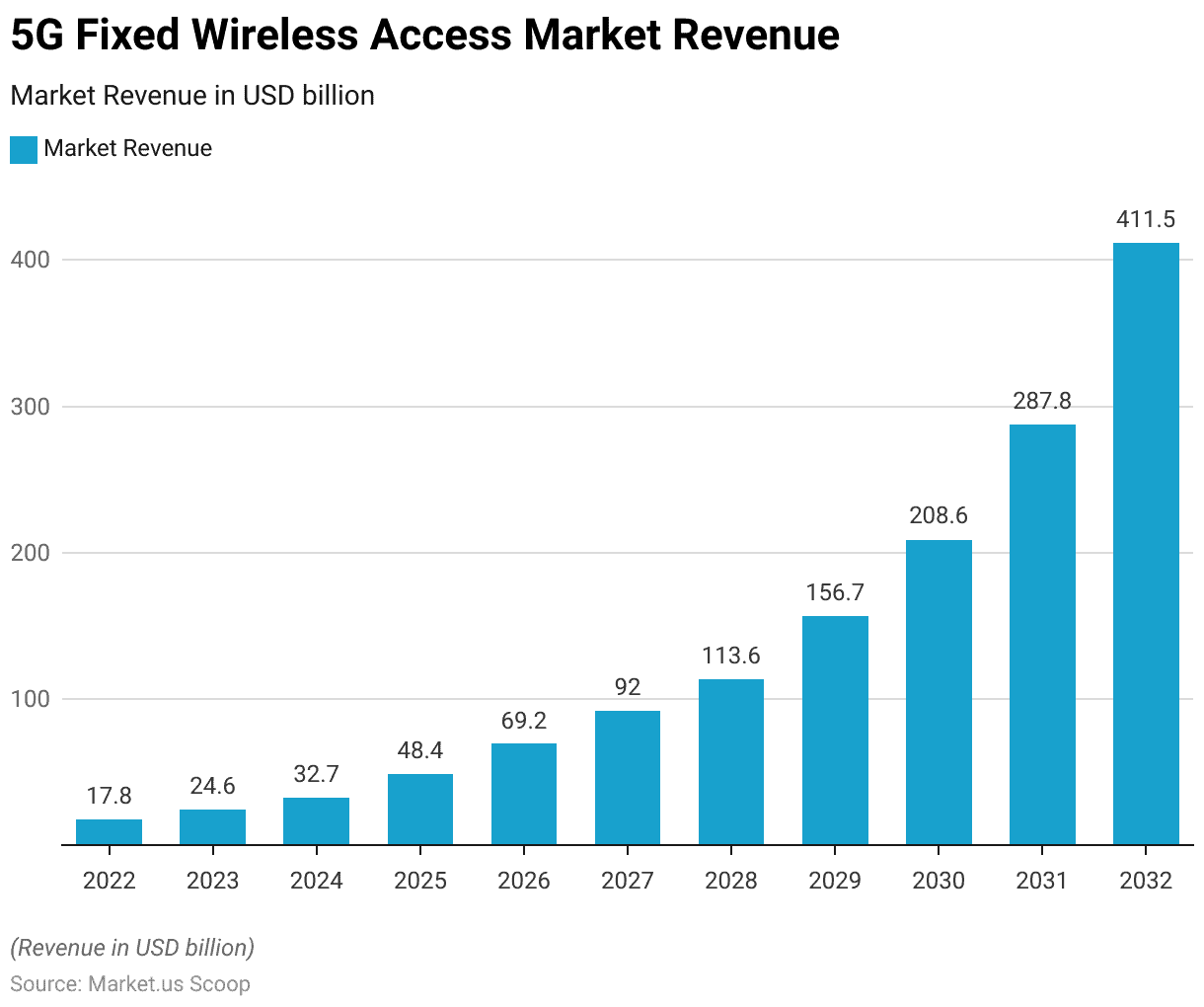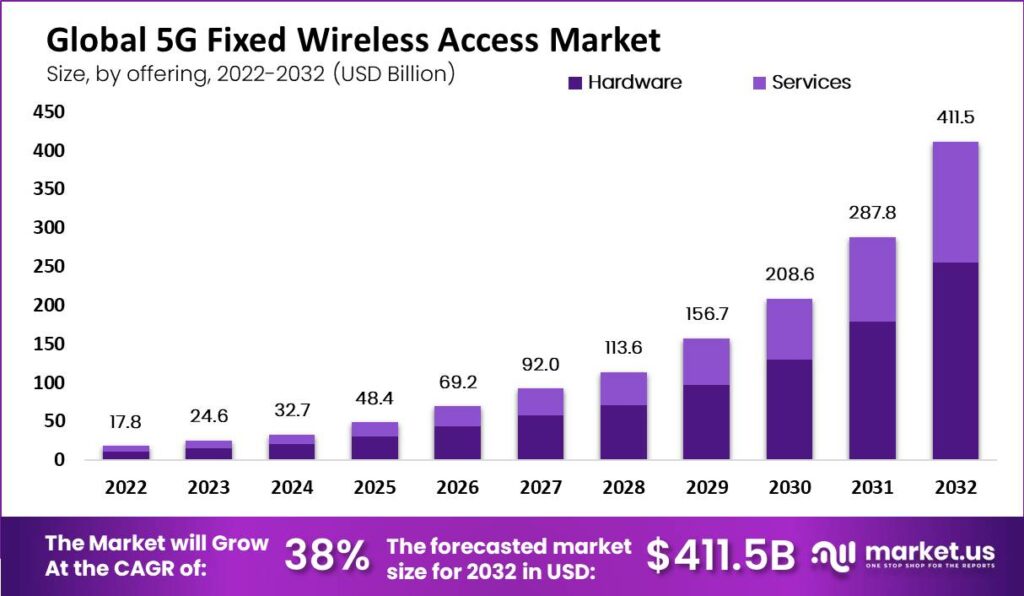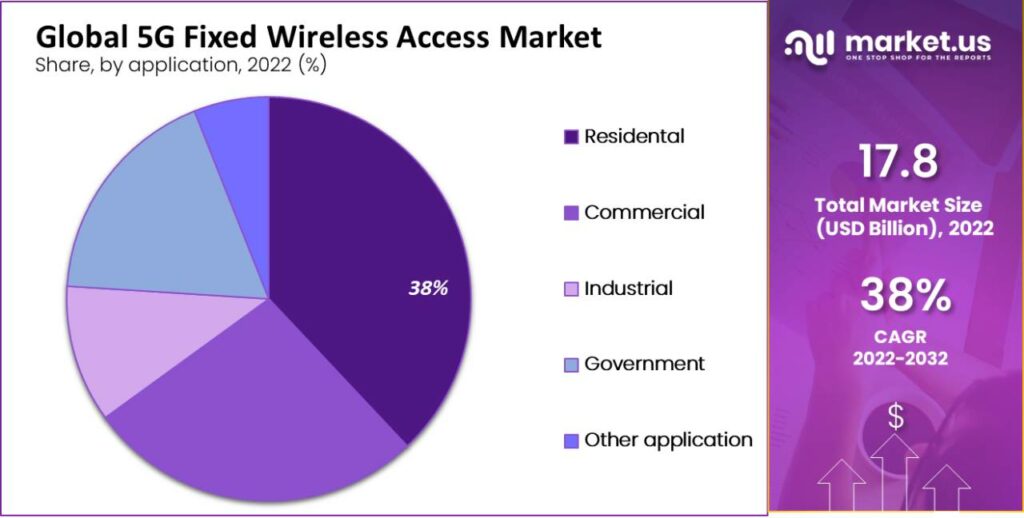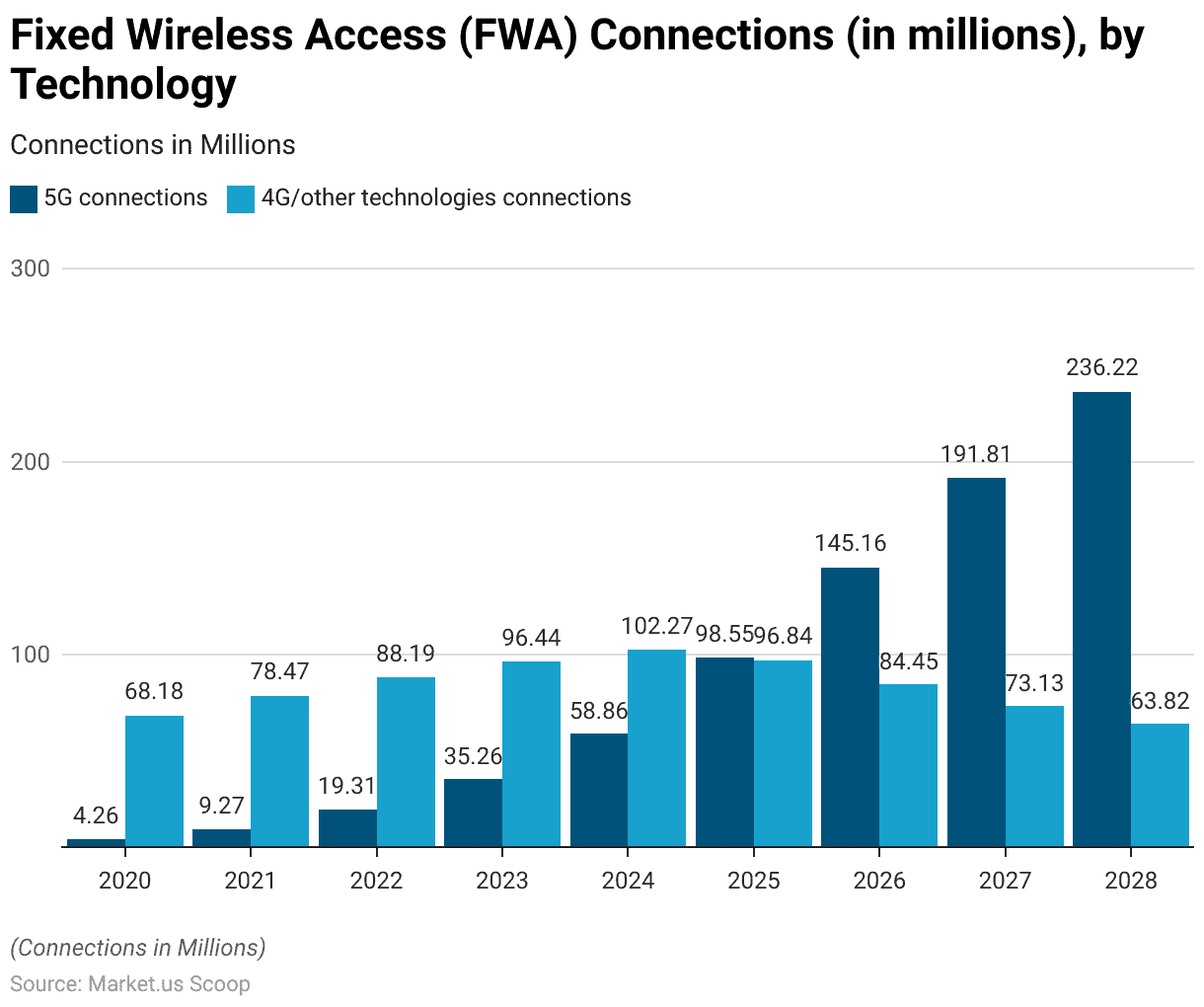Table of Contents
- Introduction
- Editor’s Choice
- Global 5G Fixed Wireless Access Market Overview
- Fixed wireless access (FWA) Connections Statistics
- Mobile 5G Subscriptions Statistics
- 5G Fixed Wireless Access Consumer Usage Pattern Statistics
- Cost Considerations in 5G Fixed Wireless Access
- Challenges in 5G Fixed Wireless Access
- Opportunities in 5G Fixed Wireless Access Regards to Spectrum
Introduction
According to 5G Fixed Wireless Access Statistics, 5G Fixed Wireless Access (FWA) represents a groundbreaking wireless technology that delivers high-speed internet connectivity through 5G networks, eliminating the necessity for physical cables.
It provides exceptionally fast speeds and minimal delays, serving a wide range of locations, including cities, suburbs, rural areas, and underserved regions, benefiting both homes and businesses. FWA also supports Internet of Things (IoT) applications and contributes to the expansion of digital services, playing a crucial role in today’s digital landscape.
With many service providers actively rolling out 5G FWA networks, it ensures improved connectivity and competitive choices in the broadband market while addressing the challenges associated with last-mile connectivity.
Editor’s Choice
- In 2022, the 5G Fixed Wireless Access market generated approximately USD 17.8 billion in revenue.
- As we moved into 2023, the market continued its ascent, reaching USD 24.6 billion in total revenue, with hardware and services generating USD 15.2 billion and USD 9.3 billion, respectively.
- In the application landscape, residential use holds the largest share, comprising 38% of the market.
- In 2020, there were 4.26 million FWA connections utilizing 5G technology and a significantly larger 68.18 million connections through 4G and other technologies.
- Cisco’s Annual Internet Report predicts that by 2021, video traffic over IP networks will constitute 82% of all consumer internet traffic, compared to 73% in 2016.
- Broadening the coverage of low band carriers beyond LTE’s 20 MHz carrier, utilizing higher numerology when feasible, and increasing PRB capacity, has the potential to bring reasonably effective service to the most remote and underserved regions using a limited number of sites.
- The mid-band, consisting of 2 GHz (B2/25 and B66A), 2.5 GHz (B41), and 3.5 GHz (B48, n77D, and future NTIA spectrum), is often viewed as an efficient choice by some analysts. It allows carriers to operate within a TDD spectrum range spanning from 5 MHz to 100 MHz.
Global 5G Fixed Wireless Access Market Overview
Global 5G Fixed Wireless Access Market Size
- The revenue of the 5G Fixed Wireless Access market has displayed a significant upward trajectory over the years at a CAGR of 38%., with consistent growth projected for the foreseeable future.
- In 2022, the market generated approximately USD 17.8 billion in revenue.
- This figure experienced a notable increase, reaching USD 24.6 billion in 2023.
- As we look further ahead, the market is poised to exceed expectations, with projected revenues of USD 156.7 billion in 2029, USD 208.6 billion in 2030, USD 287.8 billion in 2031, and an impressive USD 411.5 billion in 2032.

5G Fixed Wireless Access Market Size – By Offering
- The Global 5G Fixed Wireless Access market has shown remarkable revenue growth, categorized into hardware and services offerings.
- In 2022, the market’s total revenue stood at USD 17.8 billion, with hardware accounting for USD 11.0 billion and services contributing USD 6.8 billion.
- As we moved into 2023, the market continued its ascent, reaching USD 24.6 billion in total revenue, with hardware and services generating USD 15.2 billion and USD 9.3 billion, respectively.
- By 2030, the total market revenue is forecasted to reach USD 208.6 billion, with hardware contributing USD 129.2 billion and services adding USD 79.3 billion.
- The growth story continues into 2031 and 2032, with the market expected to achieve revenues of USD 287.8 billion and USD 411.5 billion, respectively, driven by robust contributions from both hardware and services.

Global 5G Fixed Wireless Access Market Share – By Application
- The Global 5G Fixed Wireless Access market exhibits a diverse distribution of market share across various applications.
- In this landscape, residential use holds the largest share, comprising 38% of the market.
- Commercial applications follow closely behind, accounting for 27% of the market share. Industrial sectors represent 11% of the market, highlighting their significant but relatively smaller presence.
- Government applications hold a notable 18% share, reflecting their substantial involvement in the 5G Fixed Wireless Access market.
- Additionally, other applications collectively contribute 6% to the market share, indicating a range of niche uses within this evolving industry.

Fixed wireless access (FWA) Connections Statistics
- The global landscape of Fixed Wireless Access (FWA) connections has been evolving rapidly, showcasing a substantial growth trajectory from 2020 to 2028.
- In 2020, there were 4.26 million FWA connections utilizing 5G technology and a significantly larger 68.18 million connections through 4G and other technologies.
- As we look ahead, the FWA landscape appears poised for exponential growth. In 2025, 98.55 million FWA connections are projected for 5G, while 96.84 million will rely on 4G/other technologies.
- The year 2026 is expected to witness a significant leap, with 145.16 million 5G connections and 84.45 million 4G/other technology connections.
- The trend continues its ascent, with 191.81 million 5G connections and 73.13 million 4G/other technology connections anticipated for 2027.
- Finally, in 2028, the FWA landscape is projected to reach new heights, with 236.22 million connections using 5G technology and 63.82 million relying on 4G and other technologies.

Mobile 5G Subscriptions Statistics
- The global landscape of mobile 5G subscriptions exhibits a remarkable growth pattern from 2019 to the projected figures for 2028, with regional variations reflecting the dynamic nature of the telecommunications industry.
- In 2019, South East Asia & Oceania had 0.11 million 5G subscriptions, while North East Asia led with 9.82 million.
- By 2024, the numbers soared, particularly in North East Asia, with 1101.46 million subscriptions, followed by Western Europe at 233.6 million and North America at 307.25 million.
- The forecast for 2025 and beyond remains highly promising, with all regions experiencing significant growth in 5G subscriptions.
- By 2028, the landscape is projected to reach new heights, with North East Asia at 1615.39 million subscriptions, Western Europe at 491.79 million, and North America at 405.4 million, underlining the global shift towards 5G technology and its increasing prevalence in the telecommunications market worldwide.

5G Fixed Wireless Access Consumer Usage Pattern Statistics
- Common online activities for consumers vary from basic web browsing and email usage to more data-intensive activities like video streaming and gaming, each necessitating a minimum download speed to function effectively.
- Presently, the internet is predominantly used for video-related content. Cisco’s Annual Internet Report predicts that by 2021, video traffic over IP networks will constitute 82% of all consumer internet traffic, compared to 73% in 2016.
- This encompasses data from platforms such as YouTube and BuzzFeed Video, along with popular streaming services like Netflix and Hulu.
- The necessary bit-rate or bandwidth for various well-known applications varies, ranging from basic web browsing and email services like Facebook and Google to the more demanding 4K TV and streaming experiences.
- It’s important to note that Ultra-High-Definition (UHD) video content requires nearly eight times the bandwidth compared to Standard-Definition (SD) video.
Cost Considerations in 5G Fixed Wireless Access
- Leveraging the extensive bandwidth of mmWave technology and the enhanced spectral efficiency of 5G can lead to a significant reduction in network costs, measured as cost per bit per hertz.
- This cost reduction can be achieved when the rollout of 5G Fixed Wireless Access (FWA) is meticulously planned to ensure a superior customer experience and the creation of new business opportunities.
- Improved cost efficiency will empower Communication Service Providers (CSPs) to offer Over-the-Top (OTT) services like TV and video streaming to households today, and in the future, it will enable the delivery of Augmented Reality (AR) and Virtual Reality (VR) services.
Challenges in 5G Fixed Wireless Access
- The days of accepting mediocre product designs are long gone. In today’s digital economy, the younger generation of consumers, including Gen Z and Millennials, have high expectations for products – they want them to be not only visually appealing but also seamless and user-friendly.
- As technology advances, consumers will increasingly seek a unified and easily accessible view of data. This may result in more complex products, which can be addressed in part by adding or developing new features.
- For instance, the 5G network represents a significant leap forward, unlocking the full potential of the Internet of Things (IoT).
Opportunities in 5G Fixed Wireless Access Regards to Spectrum
- Broadening the coverage of low band carriers beyond LTE’s 20 MHz carrier, utilizing higher numerology when feasible, and increasing PRB capacity, has the potential to bring reasonably effective service to the most remote and underserved regions using a limited number of sites.
- This approach can also be applied to extend the range of Mid-band Multi-User Massive Input Massive Output (MU-MIMO) deployments in the 2.5 and 3.5 GHz frequency ranges.
- The mid-band, consisting of 2 GHz (B2/25 and B66A), 2.5 GHz (B41), and 3.5 GHz (B48, n77D, and future NTIA spectrum), is often viewed as an efficient choice by some analysts. It allows carriers to operate within a TDD spectrum range spanning from 5 MHz to 100 MHz.
Discuss your needs with our analyst
Please share your requirements with more details so our analyst can check if they can solve your problem(s)



